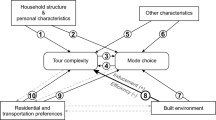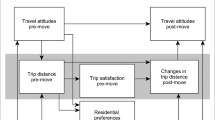Abstract
This study investigates the relationship between land use and shopping tour generation using an activity-based shopping model that captures the effects of land use patterns on household decisions of shopping tour frequency, tour scheduling and mode choice. The model was calibrated using travel data collected in three traditional neighborhoods located in the Puget Sound region, WA, and shopping travel patterns across seven common household structures were analyzed. The results reveal that land use patterns have virtually no impact on overall shopping tour frequency. However, land use does seem to be associated with decisions about the type of shopping tours undertaken. For example, households with poorer accessibility tend to make fewer one-stop shopping tours, and are more likely to combine shoppingtrips with other trips to form multi-stop shopping tours as a means of compensating for locational deficiencies. Finally, we also found that traditional neighborhood residents who live closer to the neighborhood commercial street, and thus, have greater accessibility, are more inclined to use non-auto modes for one-stop shopping tours.
Similar content being viewed by others
References
Agyemang-Duah K, Anderson WP & Hall FL (1996) Trip generation for shopping travel. Transportation Research Record 1493: 12-20.
Algers S, Daly A, Kjellman P & Widlert S (1995) Stockholm Model System (SMS): Application. Proceedings of the Seventh World Conference on Transport Research, Volume 2: Modelling Transport Systems, Sydney.
Ben-Akiva ME & Bowman JL (1996) Activity Based Disaggregate Travel Demand Model System with Daily Activity Schedules, New England University Transportation Center.
Bookout LW (1992a) Neotraditional town planning: a new vision for the suburbs? Urban Land (January): 20-26.
Bookout LW (1992b) Neotraditional town planning: toward a blending of design approaches. Urban Land (August): 14-19.
Bowman JL & Ben-Akiva M (1997) Activity-based travel forecasting. In Summary, Recommendations, and Compendium of the Activity-Based Travel Forecasting Conference, June 1996, Texas Transportation Institute, February 1997.
Crane R (1996) Cars and drivers in the new suburbs: linking access to travel in neotraditional planning. Journal of the American Planning Association 62(1): 51-65.
Dalvi MQ & Martin KM (1976) The measurement of accessibility: some preliminary results. Transportation 5: 17-42.
Ewing R, Haliyur P & Page GW (1994) Getting around a traditional city, a suburban planned unit development, and everything in between. Transportation Research Record 1466: 53-62.
Ewing R, DeAnna M & Li SC (1996) Land use impacts on trip generation rates. Transportation Research Record 1518: 1-6.
Gordon SP & Peers JB (1991) Designing a community for transportation demand management. Transportation Research Record 1321: 138-145.
Handy S (1992) Regional versus local accessibility: neo-traditional development and its implications for non-work travel. Built Environment 18(4): 253-267.
Handy S (1993) Regional versus local accessibility: implications for nonwork travel. Transportation Research Record 1400: 58-66.
Hanson S & Schwab M (1987) Accessibility and intraurban travel. Environment and Planning A 19: 735-748.
Kim H, Sen A & Christopher E (1994) Shopping trip chains: current patterns and changes since 1970. Transportation Research Record 1443: 38-44.
Kitamura R, Mokhtarian PL and Laidet L (1997) A micro-analysis of land use and travel in five neighborhoods in the San Francisco Bay Area. Transportation 24, 125-158.
Knack RE (1989) Repent, ye sinners, repent. Planning (August): 4-13.
Kockelman KM (1997) Travel behavior as function of accessibility, land use mixing, and land use balance: evidence from San Francisco Bay Area. Transportation Research Record 1607: 116-125.
Lee M & Goulias KG (1997) Accessibility Indicators for Transportation Planning Using GIS, Paper to be presented at the 76th Annual Transportation Research Board Meeting, January, 1997.
Limanond T & Niemeier D (2003) Accessibility and mode-destination choices: exploring travel in three well-mixed neighborhoods in Puget Sound, WA. Environment and Planning A, 30: 219-238.
Limanond T, Niemeier DA & Mokhtarian PL (forthcoming) Specification of a tour-based shopping model for traditional neighborhoods. Transportation (forthcoming).
McCormack E, Chang JB, Rutherford GS & Ishimaru JM (1995) The Transportation Impacts of Mixed Land-Use Neighborhoods. Report 95.7, Washington State Transportation Commission Innovations Unit, June 1995.
Oster CV (1973) Household trip making to multiple destinations: the overlooked urban travel pattern. Traffic Quarterly 32: 511-529.
RDC, Inc. (1995), Activity-Based Modeling System for Travel Demand Forecasting. Submitted to: Metropolitan Washington Council of Governments, Washington DC. http://www.bts.gov/tmip/papers/activity/amos/toc.htm Accessed: September 6, 1999.
Ryan S & McNally MG (1995) Accessibility of neotraditional neighborhoods: a review of design concepts, policies, and recent literature. Transportation Research A 29A(2): 87-105.
Spielberg F (1989) The traditional neighborhood development: how will traffic engineers respond? ITE Journal (September): 17-18.
Vickerman RW (1974) Accessibility, attraction, and potential: a review of some concepts and their use in determining mobility. Environment and Planning A 6: 675-691.
Zakaria T (1974) Urban transportation accessibility measures: modifications and uses. Traffic Quarterly 28: 467-479.
Zemotel L, Nielsen K, Rutherford GS & Ishimaru JM (1993) Travel Patterns in Mixed Use Neighborhoods. Phase I Draft Working Paper 93.6, Washington State Transportation Commission Innovations Unit, November 1993.
Author information
Authors and Affiliations
Rights and permissions
About this article
Cite this article
Limanond, T., Niemeier, D.A. Effect of land use on decisions of shopping tour generation: A case study of three traditional neighborhoods in WA. Transportation 31, 153–181 (2004). https://doi.org/10.1023/B:PORT.0000016578.21486.af
Issue Date:
DOI: https://doi.org/10.1023/B:PORT.0000016578.21486.af




